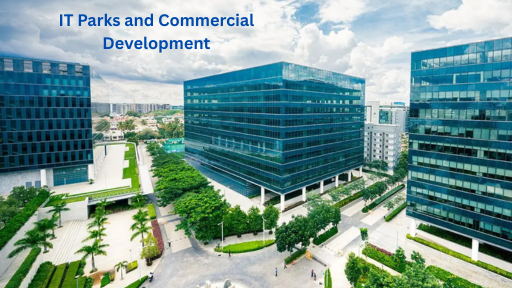IT Parks and Commercial Development
Read latest blogs and articles from Housystan

The Information mentioned here was last updated on:
11/12/2025IT Parks and Commercial Development
Information technology has become one of the strongest forces shaping today’s urban landscape. As cities look to attract global businesses, foster innovation, and create long-term economic growth, IT parks have emerged as essential hubs that bring together companies, talent and infrastructure. These technology centers do more than host corporate offices. They influence real-estate growth, improve local economies, and set the stage for new commercial development.
- Verified Tenants/Buyers
- Unlimited Property Listing
- Zero subscription/charges fee
Over the past decade, IT parks have steadily transformed into modern ecosystems where work, lifestyle and innovation coexist. Their expansion has encouraged cities to rethink how commercial spaces are built and how communities evolve around them. For businesses, these parks offer an organized setting with reliable services and easy access to skilled workers. For governments, they serve as engines for investment and development.
A Magnet for Investment and Jobs
One of the biggest impacts of IT parks is job creation. These parks bring together hundreds of technology companies ranging from global firms to new start-ups. The steady demand for skilled professionals results in consistent employment growth. This surge opens doors not only for software developers and engineers but also for support roles in administration, marketing and operations.
With more people employed in a concentrated area, businesses such as cafés, retail stores and service outlets begin to grow around these parks. This attracts investors who see strong long-term potential in commercial real estate. As a result, new office towers, business centers and mixed-use developments rise around IT corridors, turning previously quiet zones into bustling business districts.
IT parks contribute significantly to the local economy. Apart from the direct revenue generated by companies operating within them, they also drive spending in the surrounding areas. Residential property values tend to rise, transport networks expand, and public services improve.
Cities often prioritize infrastructure upgrades around these hubs. Better roads, widened highways, metro connectivity and reliable utilities become essential to support the daily movement of thousands of workers. Over time, these improvements benefit the wider population, not just those working inside the IT park.
In many regions, the presence of a major technology park has acted as a turning point for economic modernization. It signals to multinational companies that the city is ready for growth, making it easier to attract foreign investment. This chain reaction increases the city's competitiveness on a global scale.
Shaping Modern Commercial Real Estate
Commercial development around IT parks has evolved from simple office buildings to thoughtfully designed spaces that support modern work culture. Developers today understand that companies want more than just square footage. They need flexible layouts, energy-efficient buildings, and amenities that make the work environment appealing.
This has led to the rise of business parks with landscaped zones, food courts, fitness centers and co-working spaces. These additions not only enhance employee comfort but also encourage collaboration and creativity. Businesses prefer such environments because they help in attracting and retaining talent.
Additionally, commercial developers increasingly focus on mixed-use projects complexes that offer office spaces, retail outlets, entertainment areas and homes. This approach reduces commuting times, allows professionals to live closer to work, and supports a more balanced lifestyle.
IT parks often include incubation centers and startup zones. These areas provide young companies with affordable space, mentorship and exposure to industry networks. Being located in a hub with larger tech firms allows startups to connect with potential clients, partners and investors.
This environment creates a cycle of innovation. As startups grow, they bring fresh ideas and solutions. Larger companies benefit from this innovation, while smaller businesses gain opportunities to scale. Over time, entire tech ecosystems develop, making the IT park a breeding ground for new ideas and products.
Sustainable Development and Smart FeaturesModern IT parks place a strong emphasis on sustainability. Developers are adopting greener designs, such as solar panels, rainwater harvesting systems and energy-saving equipment. Green buildings not only reduce environmental impact but also lower long-term operating costs, which is attractive to companies.
Many IT parks are also integrating smart technologies. Features like automated lighting, security systems, smart parking and high-speed connectivity have become standard. These upgrades make operations smoother and improve overall efficiency for businesses operating within the park.
Impact on Lifestyle and Urban Culture
The rise of IT parks has influenced how people live, work and spend leisure time. Areas surrounding these parks usually see rapid residential development, including apartments, gated communities and serviced homes. These neighborhoods often come with modern amenities such as shopping centers, restaurants and entertainment facilities to meet the needs of young professionals.
As a result, once-quiet outskirts slowly turn into vibrant urban centers. This shift brings more diversity and activity to the city, adding to its cultural and economic dynamism.
The demand for IT parks is expected to grow as technology continues to shape industries. Emerging fields like artificial intelligence, cybersecurity and cloud services require advanced workplaces with strong digital infrastructure. Cities that invest in modern, well-planned technology parks will likely stay ahead in attracting global companies.
In the coming years, IT parks are expected to expand further into tier-2 and tier-3 cities, bringing new opportunities to regions that previously lacked large-scale commercial development. With a rising emphasis on remote and hybrid work, these parks may also evolve to offer more flexible spaces designed for collaboration rather than long hours at a desk.
As technology continues to reshape societies, IT parks will remain key drivers of urban growth, innovation and commercial expansion. They reflect the changing needs of the modern workforce and the shifting priorities of businesses in a digital era.